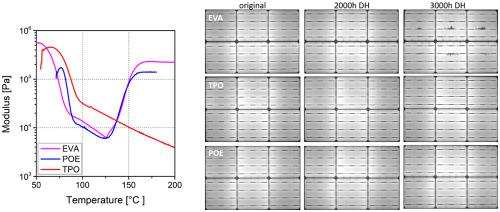当前位置:
X-MOL 学术
›
Prog. Photovoltaics
›
论文详情
Our official English website, www.x-mol.net, welcomes your feedback! (Note: you will need to create a separate account there.)
Properties and degradation behaviour of polyolefin encapsulants for photovoltaic modules
Progress in Photovoltaics ( IF 6.7 ) Pub Date : 2020-08-21 , DOI: 10.1002/pip.3323 Gernot Oreski 1 , Antonia Omazic 1 , Gabriele Christine Eder 2 , Yuliya Voronko 2 , Lukas Neumaier 3 , Wolfgang Mühleisen 3 , Christina Hirschl 3 , Gusztáv Ujvari 4 , Rita Ebner 4 , Michaell Edler 5
Progress in Photovoltaics ( IF 6.7 ) Pub Date : 2020-08-21 , DOI: 10.1002/pip.3323 Gernot Oreski 1 , Antonia Omazic 1 , Gabriele Christine Eder 2 , Yuliya Voronko 2 , Lukas Neumaier 3 , Wolfgang Mühleisen 3 , Christina Hirschl 3 , Gusztáv Ujvari 4 , Rita Ebner 4 , Michaell Edler 5
Affiliation

|
Various types of next‐generation encapsulation films based on polyolefins have recently been introduced and could attract market attention. These material innovations can be classified as polyolefin elastomer (POE) and thermoplastic polyolefin (TPO) encapsulants, both of which consist of a polyethylene backbone with different side groups. The main advantage of these materials is the replacement of the vinyl acetate side groups of state‐of‐the‐art encapsulant ethylene vinyl acetate (EVA) so that acetic acid cannot be formed. The main objective of this paper is to investigate the material properties of next‐generation encapsulant films and compare them to an EVA reference. Two commercially available EVA alternatives (POE and TPO) have been selected. The material properties of single films as well as the electrical performance of test modules using these different encapsulants were investigated. The different films show comparable optical, thermal and thermo‐mechanical properties, with slight differences in UV transparency and melting temperatures. Only shear viscosity values are higher for TPO than for POE and EVA, which requires adaption of the photovoltaic (PV) module lamination parameters. The test modules comprising the different encapsulation films show minor differences in the electrical performance after manufacturing; upon accelerated aging, no significant power loss is observed. But compared to TPO or POE, after 3000 h of damp heat exposure, test modules with EVA show the beginning of corrosion effects at the silver grid and above the ribbons. Based on the results, it can be stated that the new polyolefin encapsulation materials show great potential to be a valid replacement for EVA.
中文翻译:

用于光伏模块的聚烯烃密封剂的性能和降解行为
最近已经引入了各种类型的基于聚烯烃的下一代封装膜,它们可能引起市场关注。这些材料创新可分为聚烯烃弹性体(POE)和热塑性聚烯烃(TPO)密封剂,它们均由具有不同侧基的聚乙烯主链组成。这些材料的主要优点是替代了最先进的密封剂乙烯醋酸乙烯酯(EVA)的醋酸乙烯酯侧基,因此无法形成乙酸。本文的主要目的是研究下一代封装膜的材料特性,并将其与EVA参考进行比较。选择了两种市售的EVA替代品(POE和TPO)。研究了使用这些不同密封剂的单膜材料特性以及测试模块的电性能。不同的薄膜显示出可比的光学,热和热机械性能,但紫外线透明度和熔融温度略有不同。对于TPO,只有剪切粘度值高于POE和EVA,这需要调整光伏(PV)模块的层压参数。包含不同封装膜的测试模块在制造后在电气性能上显示出微小差异;在加速老化时,没有观察到明显的功率损耗。但是,与TPO或POE相比,经过3000个小时的潮湿热暴露后,带有EVA的测试模块显示出在银栅板上和碳带上方开始出现腐蚀作用。根据结果,
更新日期:2020-08-21
中文翻译:

用于光伏模块的聚烯烃密封剂的性能和降解行为
最近已经引入了各种类型的基于聚烯烃的下一代封装膜,它们可能引起市场关注。这些材料创新可分为聚烯烃弹性体(POE)和热塑性聚烯烃(TPO)密封剂,它们均由具有不同侧基的聚乙烯主链组成。这些材料的主要优点是替代了最先进的密封剂乙烯醋酸乙烯酯(EVA)的醋酸乙烯酯侧基,因此无法形成乙酸。本文的主要目的是研究下一代封装膜的材料特性,并将其与EVA参考进行比较。选择了两种市售的EVA替代品(POE和TPO)。研究了使用这些不同密封剂的单膜材料特性以及测试模块的电性能。不同的薄膜显示出可比的光学,热和热机械性能,但紫外线透明度和熔融温度略有不同。对于TPO,只有剪切粘度值高于POE和EVA,这需要调整光伏(PV)模块的层压参数。包含不同封装膜的测试模块在制造后在电气性能上显示出微小差异;在加速老化时,没有观察到明显的功率损耗。但是,与TPO或POE相比,经过3000个小时的潮湿热暴露后,带有EVA的测试模块显示出在银栅板上和碳带上方开始出现腐蚀作用。根据结果,



























 京公网安备 11010802027423号
京公网安备 11010802027423号